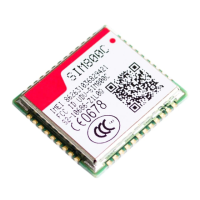
Do you have a question about the SimCom SIM800C and is the answer not in the manual?
| Brand | SimCom |
|---|---|
| Model | SIM800C |
| Category | Control Unit |
| Language | English |
Document introduces SIM800C hardware interface specifications, electrical and mechanical details.
Describes SIM800C as a quad-band GSM/GPRS module with its key features and physical characteristics.
Summarizes the various operating modes of the SIM800C module, including sleep and normal operation.
Presents a block diagram illustrating the functional components and interfaces of the SIM800C module.
Illustrates the pin configuration of the SIM800C module, showing pin numbers and names.
Details the function and I/O for each pin of the SIM800C module, categorized by interface.
Provides mechanical dimensions and footprints for the SIM800C module for PCB design.
Details the power supply requirements and reference circuits for the SIM800C module.
Explains methods for powering the SIM800C on and off, including by PWRKEY and AT commands.
Describes power saving modes like Minimum Functionality and Sleep modes for reduced current consumption.
Covers current input for RTC when VBAT is not supplied, using backup battery or capacitor.
Describes serial port and USB connections, pin definitions, and characteristics for communication.
Explains the behavior of the UART1_RI pin in response to network events like calls and SMS.
Details the analog audio input (microphone) and output (speaker) interfaces of the SIM800C.
Covers SIM card connection, application, design guides, and holder considerations for 1.8V/3V cards.
Describes the Analog-to-Digital Converter (ADC) pin used for voltage measurement.
Explains the NETLIGHT pin for network status indication and its multiplexing function.
Details the STATUS pin for indicating module power status and its multiplexing function.
Defines the RF_SYNC pin for indicating GSM burst and its use for RF Jamming detection.
Covers GSM and Bluetooth antenna interfaces, impedance, and placement recommendations.
Provides an overview of the SIM800C pin assignment for PCB layout planning.
Offers guidelines for PCB layout to minimize interference and noise across various interfaces.
Lists stress ratings for non-operating conditions that can cause permanent damage to the SIM800C.
Specifies the voltage and temperature ranges for reliable operation of the SIM800C module.
Details voltage levels for digital input and output signals of the SIM800C.
Defines current characteristics for the SIM card interface signals.
Specifies output voltage and current for the SIM card power supply.
Details output voltage and current for the VDD_EXT power output.
Describes input/output voltage and current for the VRTC pin.
Provides typical current consumption values for the SIM800C module under various conditions.
Provides guidelines for handling the ESD-sensitive SIM800C module and its ESD test results.
Covers RF output power, receive sensitivity, and operating frequencies of the SIM800C module.
Shows visual representations of the top and bottom sides of the SIM800C module.
Illustrates the temperature curve and parameters for lead-free reflow soldering processes.
Details the moisture sensitivity level and floor life of the SIM800C module.
Outlines conditions and procedures for baking the SIM800C module to prevent damage.
Lists related documents and specifications relevant to the SIM800C module.
Details the multiplexing functions for various pins, allowing them to serve multiple roles.
Provides a glossary of terms and abbreviations used throughout the SIM800C hardware design document.
Warns about safe usage of the cellular terminal/mobile in various environments like hospitals, aircraft, and vehicles.